Dee Estuary Birding
Monthly Newsletter...
November 2023 Newsletter
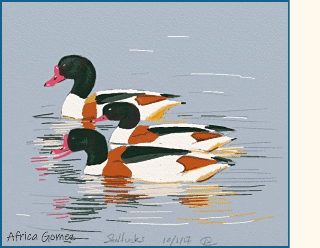
Curlew Sandpipers 2023

The best views of Curlew Sandpipers this year was undoutedly here on the mud which must have been
very rich in food as they were finding a lot to eat - mostly worms several inches long, and they
liked to dunk them in the water before swallowing them!
August and September 2023 saw another good Curlew
Sandpiper passage with the fourth highest number this century. As shown
in the bar chart these last 13 years have been particularly good with
no less than six years when numbers of Curlew Sandpipers have exceeded
any from the previous ten years.

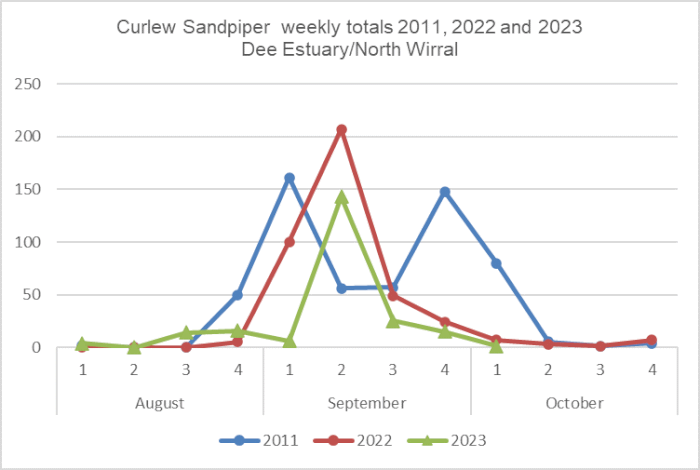
The graph above shows the weekly pattern for 2011,
2022 and 2023. 2023 was very similar to 2022 with a sharp peak
in the second week in September and, like last year, the majority of
records came from Burton Mere Wetlands with six consecutive days when
13 were present - surely too much of a coincidence not to be the same
birds. The sharp single peak is in marked contrast to 2011, when the
largest numbers this century were recorded. The graph for 2011 (and
2013 was very similar) shows two peaks, the first peak in the first
week of September, when most birds were on north Wirral, and the second
peak in the fourth week when most birds were at Burton Mere
Wetlands. We can only speculate why there is a difference
between
2011/2013 and 2022/2023, but my guess is that we get two peaks when
birds arrive from different directions - with one lot coming from the
north after flying down the west coast of Norway, and the second coming
across from the east, probably after flying through the Baltic - both
routes are known to be taken by juvenile Curlew Sandpipers. Whatever is
happening it is no doubt dependent on the weather they encounter en
route.
The vast majority of the Curlew Sandpipers we record here are juveniles which we usually start to see them around the last week in August, and from then on the passage is nearly all juveniles. Adult Curlew Sandpipers are rare and in most years we would expect to see perhaps three or four in spring with similar numbers on the return passage, usually around the end of July and early August. This extract from the 2005 Cheshire and Wirral Bird Report is typical:
Two ads on the Weaver
Bend on Jul 16th were the first returning birds with four at Hilbre the
next day;....... two on Hoylake shore on Jul 20th (the next entry was
for late Aug when the
first juveniles were seen).
The passage of adults this August (2023) was unusual because of the numbers involved, the length of time their passage went on for and how late they were. It started on the fairly typical date of August 4th with four at Burton Mere Wetlands, these were only seen briefly, which again, is typical for adults during the post-breeding period. The next sighting was of one in summer plumage at Meols on the 17th, up to three were then recorded nearly every day either at Meols or Hoylake right up to the 29th by which time we were seeing the first juveniles. In total there were 20 records of adult birds (sum of daily counts). The birds were in different stages of moult which helped when trying to estimate the total number of individuals involved over the 12 days they were here, and we reckoned at least six - four of which are shown below.
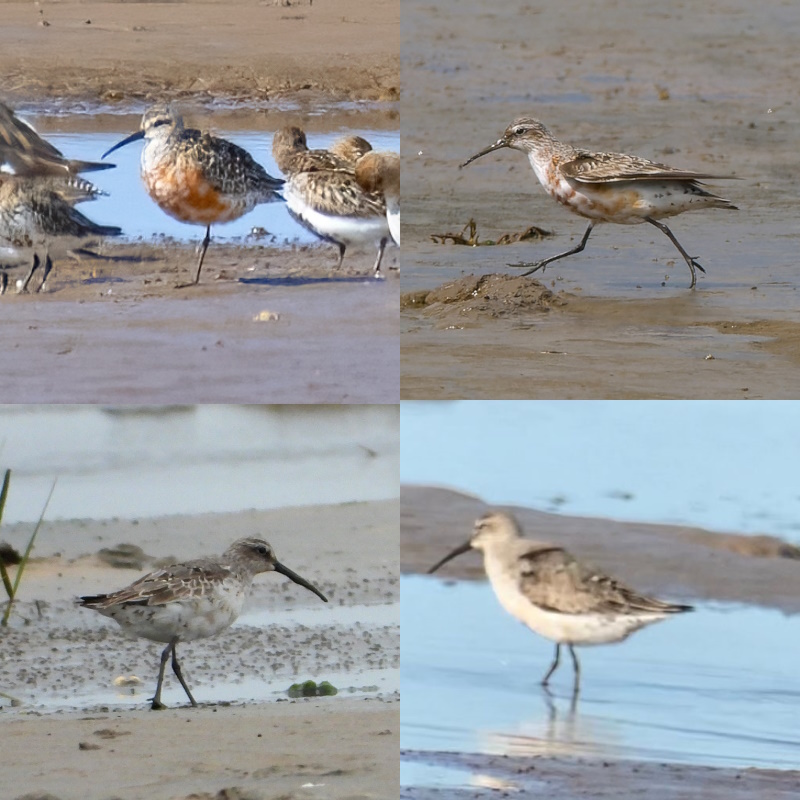
top left by Frank Burns August 22nd : top right by Mark Woodhead August 21st
bottom left by Richard Smith August 29th : bottom right by Sean O'Hara August 24th
How unusual was this passage of adults in the second
half of August? Looking at the Bird Reports it's obvious that there
have been very few records of adults in late August, and the last one
seen before 2023 seems to have been a moulting bird on Hilbre on August
20th 2020. There was an interesting record from Hoylake on August 20th
2016 when 9 Curlew Sandpipers were seen including two adults, and on
August 24th 2015 there was an adult at Burton Mere Wetlands. That,
then, seems to be the pattern of records with just the occasional one
or two adults seen and usually briefly. So we can look back at the 2023
Curlew Sandpiper passage knowing that we've seen something a bit
special!
Richard Smith
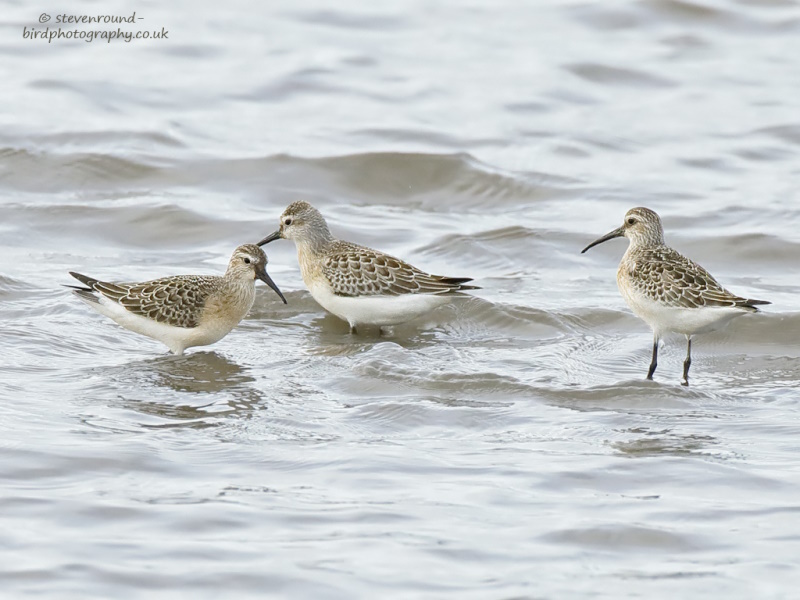
© Steve Round
North-East Wales Bird Report 2022
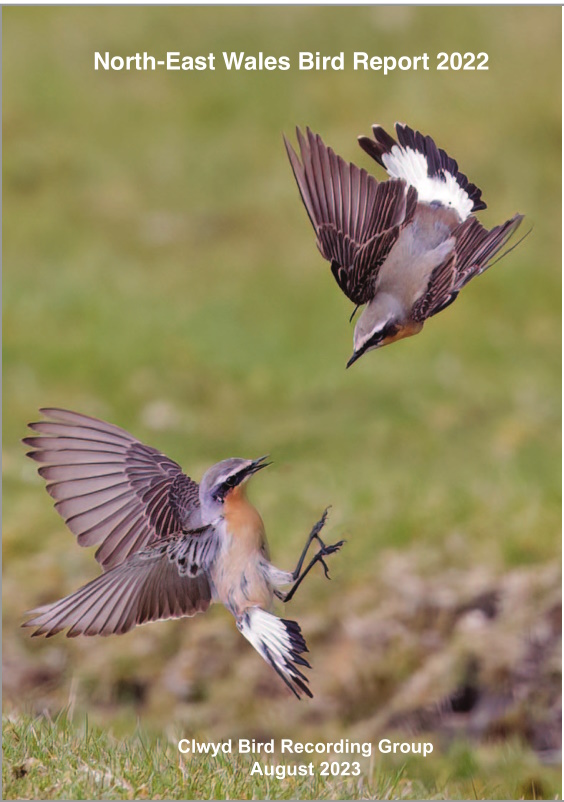
The North-East Wales Bird Report for 2022 has been
published and is freely available by clicking this link and downloading
- https://www.cofnod.org.uk/CBRG.
As you will see the Bird Reports (Clwyd Bird
Reports up to 2003, Nort-East Wales Bird Reports after 2003) going
back to 1975 are all freely available to download making for a
tremendously useful resource for those interested in historical records
and how the status of species compares to the present. As far as the
Dee
Estuary is concerned these cover the area from Gronant to Point of Ayr,
then down the west coast of the estuary (including Flint and Connah's
Quay) then across the head of the estuary, passing Shotton Lagoons, and
up to the Wales/England Border within RSPB Burton Mere Wetlands.
For the 2022 Report I quote from the first three
paragraphs of the introduction
written by the North-East Wales Bird Recorder Glenn Morris:
Once again this year, the
reader is referred to the 2019-20 Report for background details about
the status of each species in Flintshire (Flints) and Denbighshire
(Denbs) and for a generally“good read”. The main objectives of this
Report are to record unusual sightings, breedingevidence and high
counts for each species and to acknowledge the efforts of people
submitting
data. Where extra description or photos have been submitted, via
Birdtrack or directly, I have incorporated these enthusiastically into
the text.
This Report is based almost entirely on data provided in spreadsheet
form by Cofnod, BTO (Birdtrack, Garden Birdwatch, BBS, WBBS) and WeBS,
plus other sources (RSPB [Graham Jones, Neil Friswell and Colin Wells],
DNS Report 2022, eBird, Dee estuary website (DEW), direct submissions).
Unusual records for 2022 include White-tailed Eagle, White Stork,
Caspian Gull, Puffin, Hoopoe, Little Gull, Arctic Terns in November,
Black Tern and our first “wild” Snow Goose.
Colour Ring Report
Knots

The big numbers of Knots don't arrive until November
so we did well to read 15 Orange flagged birds, plus two ringed by the
Dutch, from the few hundred present through October - four of which are
shown above.
2023 was a very good breeding season for them and
some of the juveniles have already been caught and fitted with flags -
including over 50 on Cardigan Bay (Ynyslas point) by the Mid-Wales
Ringing Group. It always amazes us that these juveniles, ringed on
Cardigan Bay, find their way to Liverpool Bay. How do they know where
to go? We saw five of these juveniles (21A, above, is one of them) in
October - so one tenth of those flagged in September have already found
their way to Meols and Hoylake.
We were also particularly pleased to see 13C, it had been flagged at
Hoylake by the Merseyside Ringing Group in November 2022 and it was one
of their ringers who photographed it at high tide at Hoylake on October
31st.
Of the other ones photographed (above) 67E was flagged at Ainsdale in March 2022 and has been recorded several times at Meols and Hoylake since, but also seen in Iceland in both May 2022 and 2023. 93M was flagged at Altcar in April 2023.
It was good to see Orange flag X7 at Hoylake on
October 31st as it was caught and flagged in the first catch at Altcar
in September 2017, and one of the first of these Orange flagged Knots I
saw when it turned up a few yards from my house at the Caldy Wildfowl
Collection in early October 2017. Since then it has been a regular over
at Formby and at Thurstaston, and was recorded in Iceland in both May
2018 and 2022. (Photograph below of X7 at Thurstaston in November 2020,
taken
by Richard Smith).

Grey Plovers
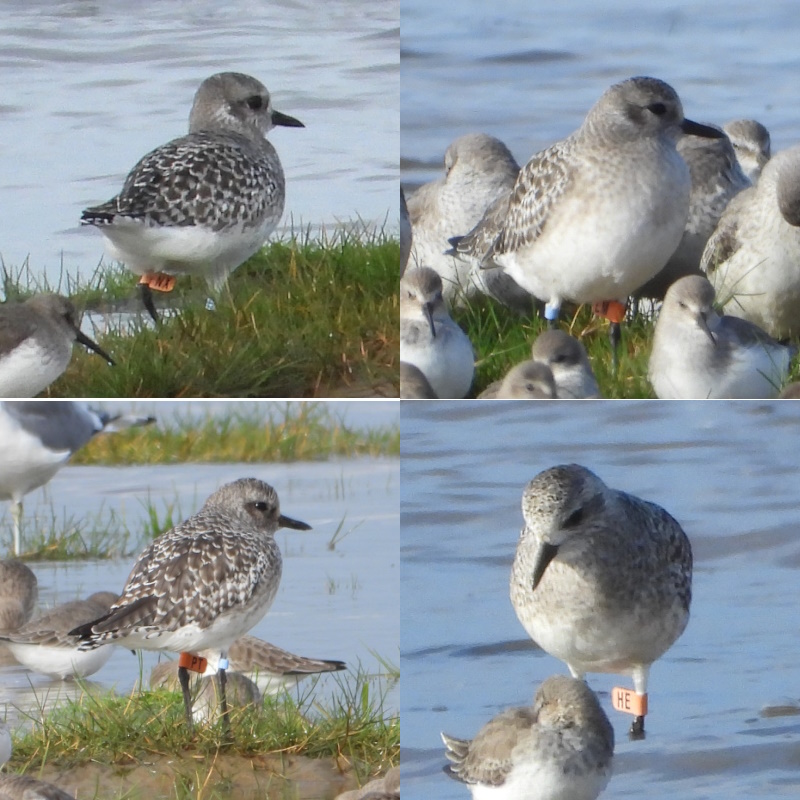
With their long legs the Orange flags fitted to Grey
Plovers can be read even standing in water, or standing in long grass.
The high tides at the end of October brought them relatively close to
Hoylake promenade and we saw a total of 10 in a nice undisturbed wader
roost. They've also been seen at West Kirby and Meols at low tide
bringing the total recorded in September and October to 19, with a few
seen several times.
These Grey Plovers seem to be remarkably site
faithful. For example, Orange flag HE (photo above) has been recorded a
total of 34 times since it was flagged in March 2018, and always
in the area between Ainsdale, Formby and across to Hoylake.
Dunlins
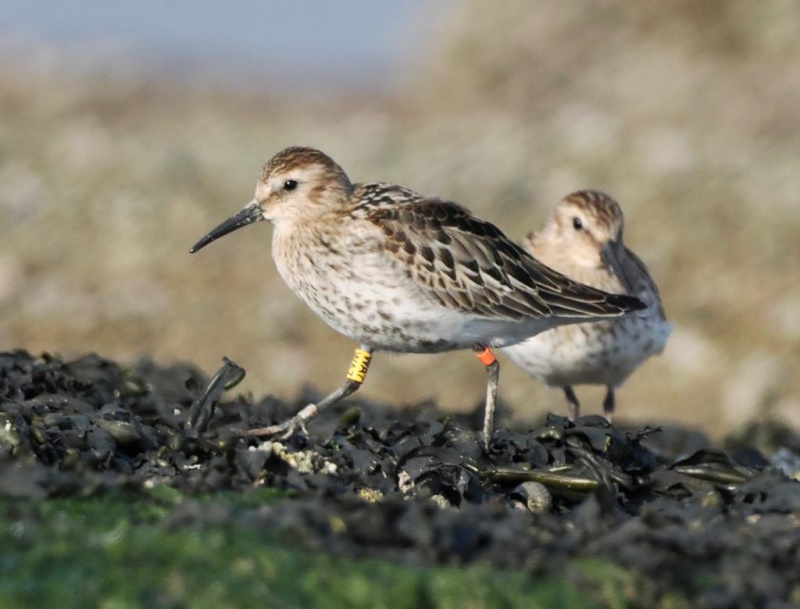
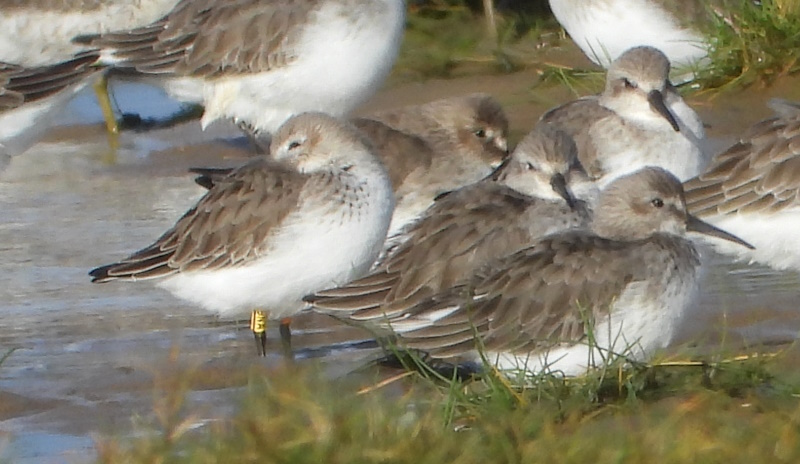
Both these yellow ring Dunlin were ringed by the Mid-Wales Ringing
Group at Ynyslas (Cardigan Bay). WA7 on September 1st 2023 and 8NA on
September 28th 2022.
Oystercatcher
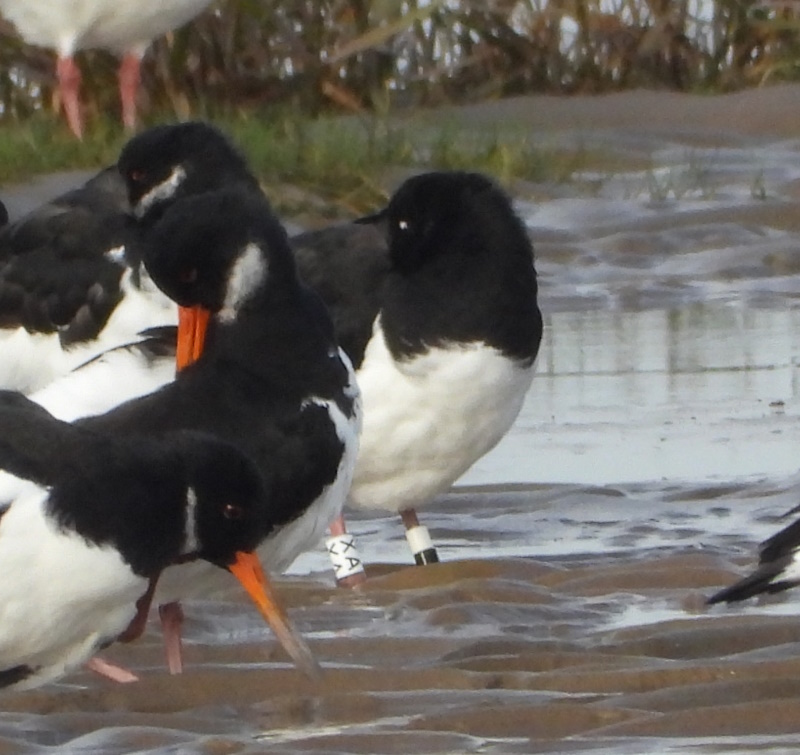
WN - W(XA)
Ringed at Fljótshlíð in southern Iceland on 26/05/2022, an incubating
female.
Recorded Hoylake Shore on 30/10/23.
It wasn't seen at the nesting site in 2023 and the ringer thought it had moved elsewhere to breed due to high predation in the area.
Rock Pipit
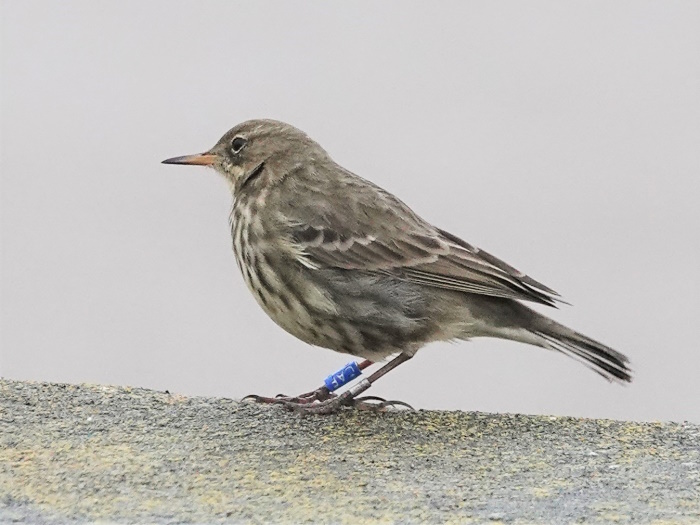
Blue (CAF)
One of the birds ringed on Hilbre as part of the project studying Rock
Pipit movements of the birds which visit, and breed on the island.
To quote Phil Woollen of the Hilbre Bird Observatory "A few pairs breed
on Hilbre & we started the project this year to try & find out
more about their movements as we know we get Scandinavian birds passing
through in the winter (we’ve caught a Norwegian ringed bird). CAF was
ringed as a juvenile on the 4th August this year and appears to be a
classic case of post juvenile dispersal as it has now been recorded
several times at Meols"
Colour Rings were recorded by Richard Smith, Stephen
Hinde, Alex Jones, Alan Hitchmough, Tony Ormond, Sean O'Hara, Steve
Williams and Ed Wilson.
Richard Smith
October Bird News


Both Hen Harriers and Short-eared Owls showed well in October.
Unusually, a ringtail Hen Harrier was seen to fly over Hilbre and a
grey male high over Hoylake, both on the 17th. On the marshes at least
six were recorded with five ringtails and one grey male on the 28th.
There was a mass movement of Pink-footed Geese into
the estuary on the 8th, with more arriving over the rest of the month
and giving wonderful views - particularly when they flew over Burton
Mere Wetlands in their thousands.
October lived up to it's reputation for rarities and included a Pectoral Sandpiper, six Yellow-browed Warblers, two Lapland Buntings, a Long-tailed Duck, one Richard's Pipit and a Pallas's Warbler.
Other highlights inluded 19 Cattle Egrets at Burton
Mere Wetlands, 23 Red-breasted Mergansers off Heswall Marsh, a flock of
11 Greenshanks in the channel at Heswall Shore and 15,000 Dunlin on
West Kirby Shore. Not such big numbers at Hoylake but it was nice to
have a good selection of species in an undisturbed roost during the
spring tides at the end of the month.
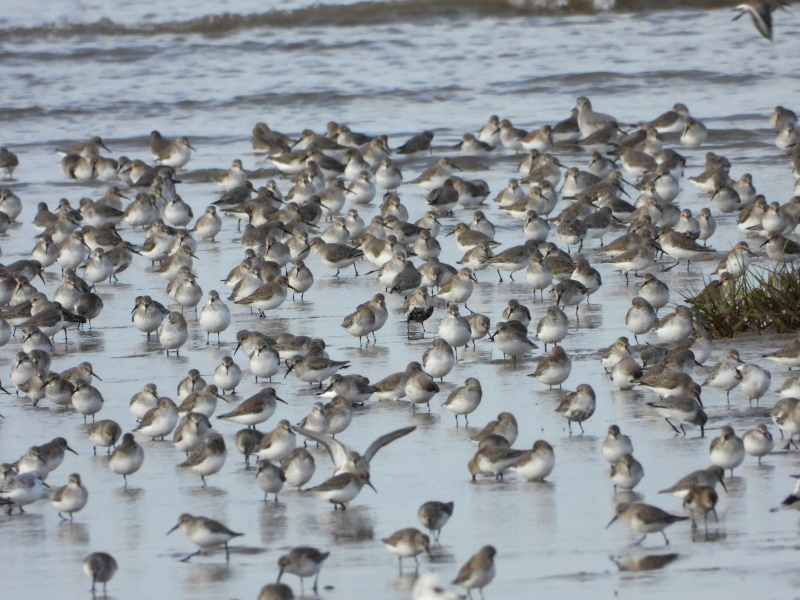
What to expect in November
There was a big influx of Short-eared Owls into the
country in October (as per BirdGuides), we've already seen several on
the marshes and hopefully we'll see plenty more over the winter. Hen
Harrier numbers are also looking good.
There will be noticeable change as far as waders are
concerned with the Icelandic breeding Dunlin (schinzii), which spent August and
September here, having already disappeared to spend the winter in
West Africa, being replaced by those which breed in northern Europe and
western Siberia (alpina).
There will also be a big increase in Knot numbers with birds having
completed their moult on the Ribble Estuary, the Wash and Waddensea
flying
in to spend the winter with us. Look out for both species on the mud
between West Kirby and Thurstaston and out on Dawpool Bank - 20,000 of
each is typical. Purple
Sandpipers will return for the winter, numbers are sadly not as high as
they used to be but we could get up to ten both at Hilbre and the
New Brighton Marine Lake roost at high tide.
Brent Geese numbers should reach several hundred around Hilbre and are
also often seen on West Kirby Shore, particularly at high tide, with a
few scattered elsewhere including Thurstaston and Point of Ayr.
High tide on a bright calm day is the time to look out to sea along north Wirral, there should be several thousand Common Scoters out there, last November a Long-tailed Duck was spotted and it turned out to be the first of a small flock which over-wintered. A few hundred Great Crested Grebes are often seen at high tide, usually off Meols.
The first Snow Buntings should be seen in November,
they can turn up almost anywhere but the embankment between Wallasey
Shore (Derby Pool) and Meols is a favourite place, as is Point of Ayr
beach and the sandy stretch to Gronant.
Forthcoming Events
November Highest Spring Tides (Liverpool)
Also see Tides page.
14th November, 11.20hrs (GMT), 9.3m.
15th November, 11.55hrs (GMT), 9.3m.
27th November, 10.41hrs (GMT), 9.3m.
28th November, 11.21hrs (GMT), 9.4m.
29th November, 11.59hrs (GMT), 9.3m.
Forthcoming Events
Also see events at https://events.rspb.org.uk/deeestuary